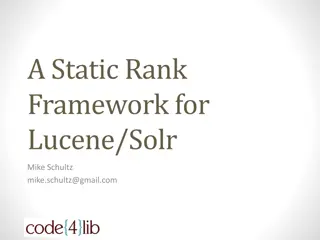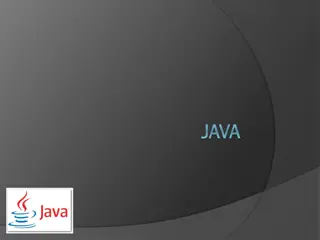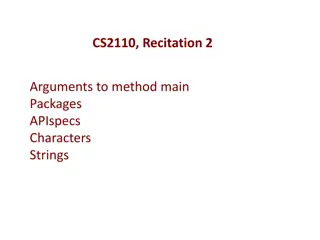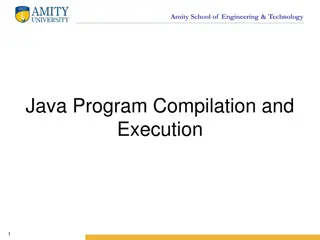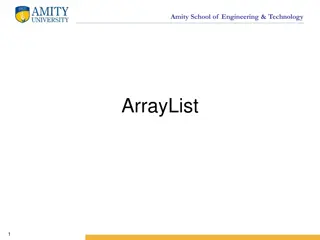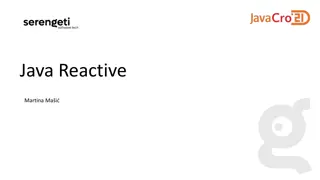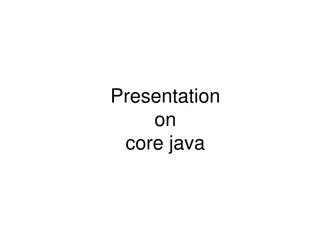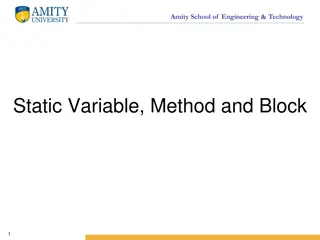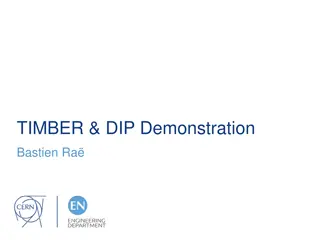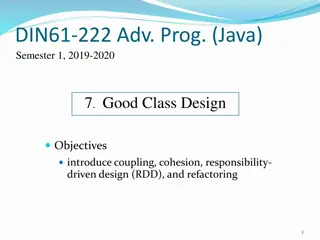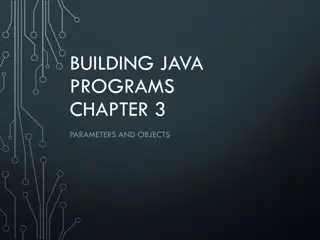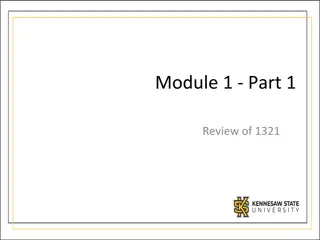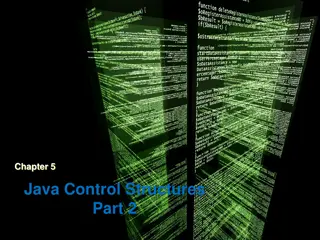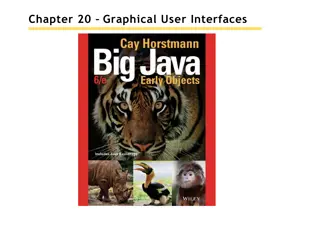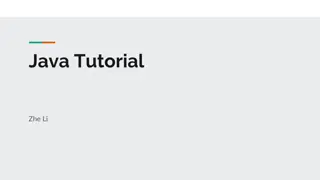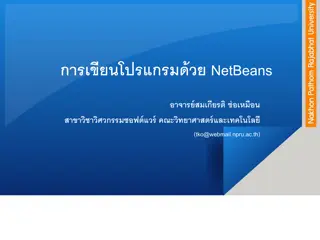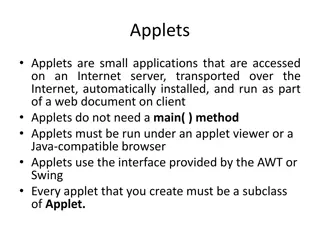Introduction to Lucene: Open Source Java Library for IR
Lucene is an open-source Java library for information retrieval, allowing you to add search capabilities to your applications. It is widely used by companies like LinkedIn, Twitter, and Netflix, with ports to other languages. The tool facilitates indexing, searching, and building search functionalities in various applications.
Download Presentation

Please find below an Image/Link to download the presentation.
The content on the website is provided AS IS for your information and personal use only. It may not be sold, licensed, or shared on other websites without obtaining consent from the author. Download presentation by click this link. If you encounter any issues during the download, it is possible that the publisher has removed the file from their server.
E N D
Presentation Transcript
Introduction to Information Retrieval Introduction to Information Retrieval 70: : Lucene. 1
Introduction to Information Retrieval ; Open source Java library for IR (indexing and searching) Lets you add search to your application, not a complete search system by itself -- software library not an application Written by Doug Cutting Used by LinkedIn, Twitter, Netflix and many more (see http://wiki.apache.org/lucene-java/PoweredBy) Ports/integrations to other languages C/C++, C#, Ruby, Perl, Python, PHP, Beyond core jar, a number of extension modules contrib modules
Introduction to Information Retrieval Lucene: http://lucene.apache.org/core/ Lucene in Action: http://www.manning.com/hatcher3/ Code samples available for download JUnit: http://junit.org/ Some examples are JUnit test cases Automatically executes all methods with public void test-XXX() signature
Introduction to Information Retrieval Lucene in a search system Index document Users Analyze document Search UI Build document Index Build query Render results Acquire content Run query Raw Content INDEX SEARCH
Introduction to Information Retrieval Lucene in a search system: index Index document Analyze document Steps 1. Acquire content 2. Build content 3. Analyze documents 4. Index documents Build document Index Acquire content Raw Content INDEX
Introduction to Information Retrieval Lucene in a search system: index Acquire content (not supported by core Lucid) Depending on type Crawler or spiders (web) Specific APIs provided by the application (e.g., Twitter, FourSquare) Complex software if scattered at various location, etc Additional issues Access Control Lists Online/real-time Complex documents (e.g., XML, relational databases, etc) Solr (Tika, chapter 7)
Introduction to Information Retrieval Lucene in a search system: index Build document (not supported by core Lucid) A document is the unit of search Each document consists of separately named fields with values (title, body, etc) What constitutes a document and what are its fields? Lucene provides an API for building fields and documents Other issues (not handled) Extract text from document (if binary) Handle markups (XML, HTML) Add additional fields (semantic analysis) Boost individual files At indexing time (per document and field, section 2.5) At query time (section 5.7)
Introduction to Information Retrieval Lucene in a search system: index Analyze document (supported by core Lucid) Given a document -> extract its tokens Details in Chapter 4 Issues handle compounds case sensitivity inject synonyms spell correction collapse singular and plural stemmer (Porter s)
Introduction to Information Retrieval Lucene in a search system: index Index document (supported by core Lucid) Details in Chapter 2
Introduction to Information Retrieval Lucene in a search system: search Users STEPS Enter query (UI) Build query Run search query Render results (UI) Search UI Index Build query Render results Run query SEARCH
Introduction to Information Retrieval Lucene in a search system: search Search User Interface (UI) No default search UI, but many useful contrib modules General instructions Simple (do not present a lot of options in the first page) a single search box better than 2-step process Result presentation is important highlight matches (highlighter contrib modules, section 8.3&8.4) make sort order clear, etc Be transparent: e.g., explain if you expand search for synonyms, autocorrect errors (spellchecker contrib module, section 8.5 , etc)
Introduction to Information Retrieval Lucene in a search system: search Build query (supported by core Lucid) Provides a package QueryParser: process the user text input into a Query object (Chapter 3) Query may contain Boolean operators, phrase queries, wildcard terms
Introduction to Information Retrieval Lucene in a search system: search Search query (supported by core Lucid) See Chapter 6 Three models Pure Boolean model (no sort) Vector space model Probabilistic model Lucene combines Boolean and vector model select which one on a search-by-search basis Customize
Introduction to Information Retrieval Lucene in a search system: search Render results (supported by core Lucid) UI issues
Introduction to Information Retrieval Lucene in action Get code from the book Command line Indexer /lia2e/src/lia/meetlucene/Indexer.java Command line Searcher /lia2e3/src/lia/meetlucene/Searcher.java
Introduction to Information Retrieval How Lucene models content A Document is the atomic unit of indexing and searching A Document contains Fields Fields have a name and a value Examples: Title, author, date, abstract, body, URL, keywords, .. Different documents can have different fields You have to translate raw content into Fields Search a field using name:term, e.g., title:lucene
Introduction to Information Retrieval Documents and Fields Parametric or zone indexing There is one (parametric) index for each field Also, supports weighted field scoring
Basic Application Document super_name: Spider-Man name: Peter Parker category: superhero powers: agility, spider-sense Query Hits (powers:agility) (Matching Docs) 1. Get Lucene jar file addDocument() search() 2. Write indexing code to get data and create Document objects IndexWriter IndexSearcher 3. Write code to create query objects Lucene Index 4. Write code to use/display results
Introduction to Information Retrieval Core indexing classes IndexWriter Central component that allows you to create a new index, open an existing one, and add, remove, or update documents in an index Directory Abstract class that represents the location of an index Analyzer Extracts tokens from a text stream
Introduction to Information Retrieval Creating an IndexWriter import org.apache.lucene.index.IndexWriter; import org.apache.lucene.store.Directory; import org.apache.lucene.analysis.standard.StandardAnalyzer; ... private IndexWriter writer; ... public Indexer(String indexDir) throws IOException { Directory dir = FSDirectory.open(new File(indexDir)); writer = new IndexWriter( dir, new StandardAnalyzer(Version.LUCENE_30), true, IndexWriter.MaxFieldLength.UNLIMITED); }
Introduction to Information Retrieval Core indexing classes Document Represents a collection of named Fields. Text in these Fields are indexed. Field Note: Lucene Fields can represent both fields and zones as described in the textbook
Introduction to Information Retrieval A Document contains Fields import org.apache.lucene.document.Document; import org.apache.lucene.document.Field; ... protected Document getDocument(File f) throws Exception { Document doc = new Document(); doc.add(new Field("contents , new FileReader(f))) doc.add(new Field("filename , f.getName(), Field.Store.YES, Field.Index.NOT_ANALYZED)); doc.add(new Field("fullpath , f.getCanonicalPath(), Field.Store.YES, Field.Index.NOT_ANALYZED)); return doc; }
Introduction to Information Retrieval Index a Document with IndexWriter private IndexWriter writer; ... private void indexFile(File f) throws Exception { Document doc = getDocument(f); writer.addDocument(doc); }
Introduction to Information Retrieval Indexing a directory private IndexWriter writer; ... public int index(String dataDir, FileFilter filter) throws Exception { File[] files = new File(dataDir).listFiles(); for (File f: files) { if (... && (filter == null || filter.accept(f))) { indexFile(f); } } return writer.numDocs(); }
Introduction to Information Retrieval Closing the IndexWriter private IndexWriter writer; ... public void close() throws IOException { writer.close(); }
Introduction to Information Retrieval Fields Fields may Be indexed or not Indexed fields may or may not be analyzed (i.e., tokenized with an Analyzer) Non-analyzed fields view the entire value as a single token (useful for URLs, paths, dates, social security numbers, ...) Be stored or not Useful for fields that you d like to display to users Optionally store term vectors Like a positional index on the Field s terms Useful for highlighting, finding similar documents, categorization
Introduction to Information Retrieval Field construction Lots of different constructors import org.apache.lucene.document.Field Field(String name, String value, Field.Store store, // store or not Field.Index index, // index or not Field.TermVector termVector); value can also be specified with a Reader, a TokenStream, or a byte[]
Introduction to Information Retrieval Field options Field.Store NO : Don t store the field value in the index YES : Store the field value in the index Field.Index ANALYZED : Tokenize with an Analyzer NOT_ANALYZED : Do not tokenize NO : Do not index this field Couple of other advanced options Field.TermVector NO : Don t store term vectors YES : Store term vectors Several other options to store positions and offsets
Introduction to Information Retrieval Field vector options TermVector.Yes TermVector.With_POSITIONS TermVector.With_OFFSETS TermVector.WITH_POSITIONS_OFFSETS TermVector.No
Introduction to Information Retrieval Using Field options Index Store TermVector Example usage NOT_ANALYZED YES NO Identifiers, telephone/SSNs, URLs, dates, ... ANALYZED YES WITH_POSITIONS_OFFSETS Title, abstract ANALYZED NO WITH_POSITIONS_OFFSETS Body NO YES NO Document type, DB keys (if not used for searching) NOT_ANALYZED NO NO Hidden keywords
Introduction to Information Retrieval Document import org.apache.lucene.document.Field Constructor: Document(); Methods void add(Fieldable field); // Field implements String get(String name); // Returns value of Fieldable getFieldable(String name); ... and many more // Fieldable // Field with given // name
Introduction to Information Retrieval Multi-valued fields You can add multiple Fields with the same name Lucene simply concatenates the different values for that named Field doc.add(new Field( author , doc.add(new Field( author , ... Document doc = new Document(); chris manning , Field.Store.YES, Field.Index.ANALYZED)); prabhakar raghavan , Field.Store.YES, Field.Index.ANALYZED));
Introduction to Information Retrieval Analyzers Tokenizes the input text Common Analyzers WhitespaceAnalyzer Splits tokens on whitespace SimpleAnalyzer Splits tokens on non-letters, and then lowercases StopAnalyzer Same as SimpleAnalyzer, but also removes stop words StandardAnalyzer Most sophisticated analyzer that knows about certain token types, lowercases, removes stop words, ...
Introduction to Information Retrieval Analysis examples The quick brown fox jumped over the lazy dog WhitespaceAnalyzer [The] [quick] [brown] [fox] [jumped] [over] [the] [lazy] [dog] SimpleAnalyzer [the] [quick] [brown] [fox] [jumped] [over] [the] [lazy] [dog] StopAnalyzer [quick] [brown] [fox] [jumped] [over] [lazy] [dog] StandardAnalyzer [quick] [brown] [fox] [jumped] [over] [lazy] [dog]
Introduction to Information Retrieval More analysis examples XY&Z Corporation xyz@example.com WhitespaceAnalyzer [XY&Z] [Corporation] [-] [xyz@example.com] SimpleAnalyzer [xy] [z] [corporation] [xyz] [example] [com] StopAnalyzer [xy] [z] [corporation] [xyz] [example] [com] StandardAnalyzer [xy&z] [corporation] [xyz@example.com]
Introduction to Information Retrieval What s inside an Analyzer? Analyzers need to return a TokenStream public TokenStream tokenStream(String fieldName, Reader reader) TokenStream Tokenizer TokenFilter Reader Tokenizer TokenFilter TokenFilter
Introduction to Information Retrieval Tokenizers and TokenFilters Tokenizer WhitespaceTokenizer KeywordTokenizer LetterTokenizer StandardTokenizer ... TokenFilter LowerCaseFilter StopFilter PorterStemFilter ASCIIFoldingFilter StandardFilter ...
Introduction to Information Retrieval Adding/deleting Documents to/from an IndexWriter void addDocument(Document d); void addDocument(Document d, Analyzer a); Important: Need to ensure that Analyzers used at indexing time are consistent with Analyzers used at searching time // deletes docs containing term or matching // query. The term version is useful for // deleting one document. void deleteDocuments(Term term); void deleteDocuments(Query query);
Introduction to Information Retrieval Index format Each Lucene index consists of one or more segments A segment is a standalone index for a subset of documents All segments are searched A segment is created whenever IndexWriter flushes adds/deletes Periodically, IndexWriter will merge a set of segments into a single segment Policy specified by a MergePolicy You can explicitly invoke optimize() to merge segments
Introduction to Information Retrieval Basic merge policy Segments are grouped into levels Segments within a group are roughly equal size (in log space) Once a level has enough segments, they are merged into a segment at the next level up
Introduction to Information Retrieval Core searching classes
Introduction to Information Retrieval Core searching classes IndexSearcher Central class that exposes several search methods on an index (a class that opens the index) requires a Directory instance that holds the previously created index Term Basic unit of searching, contains a pair of string elements (field and word) Query Abstract query class. Concrete subclasses represent specific types of queries, e.g., matching terms in fields, boolean queries, phrase queries, , most basic TermQuery QueryParser Parses a textual representation of a query into a Query instance
Introduction to Information Retrieval Creating an IndexSearcher import org.apache.lucene.search.IndexSearcher; ... public static void search(String indexDir, String q) throws IOException, ParseException { Directory dir = FSDirectory.open( new File(indexDir)); IndexSearcher is = new IndexSearcher(dir); ... }
Introduction to Information Retrieval Query and QueryParser import org.apache.lucene.search.Query; import org.apache.lucene.queryParser.QueryParser; ... public static void search(String indexDir, String q) throws IOException, ParseException ... QueryParser parser = new QueryParser(Version.LUCENE_30, "contents , new StandardAnalyzer( Query query = parser.parse(q); ... } Version.LUCENE_30));
Introduction to Information Retrieval Core searching classes (contd.) TopDocs Contains references to the top N documents returned by a search (the docID and its score) ScoreDoc Provides access to a single search result
Introduction to Information Retrieval search() returns TopDocs import org.apache.lucene.search.TopDocs; ... public static void search(String indexDir, throws IOException, ParseException ... IndexSearcher is = ...; ... Query query = ...; ... TopDocs hits = is.search(query, 10); } String q)
Introduction to Information Retrieval TopDocs contain ScoreDocs import org.apache.lucene.search.ScoreDoc; ... public static void search(String indexDir, String q) throws IOException, ParseException ... IndexSearcher is = ...; ... TopDocs hits = ...; ... for(ScoreDoc scoreDoc : hits.scoreDocs) { Document doc = is.doc(scoreDoc.doc); System.out.println(doc.get("fullpath")); } }
Introduction to Information Retrieval Closing IndexSearcher public static void search(String indexDir, throws IOException, ParseException ... IndexSearcher is = ...; ... is.close(); } String q)
Introduction to Information Retrieval IndexSearcher Constructor: IndexSearcher(Directory d); deprecated
Introduction to Information Retrieval IndexReader Query TopDocs IndexSearcher IndexReader Directory




